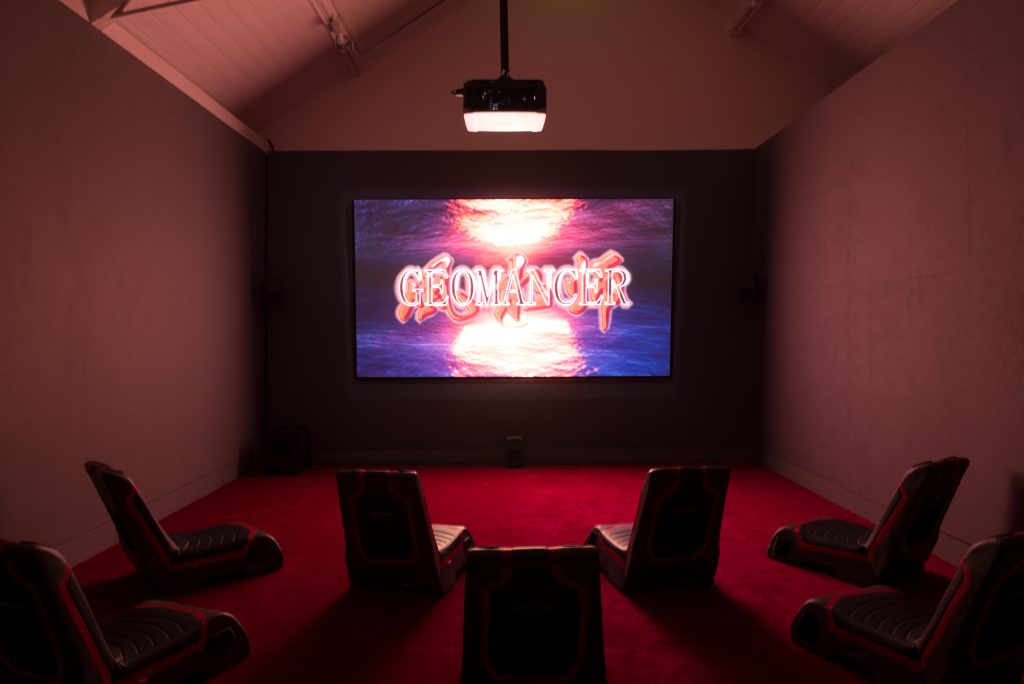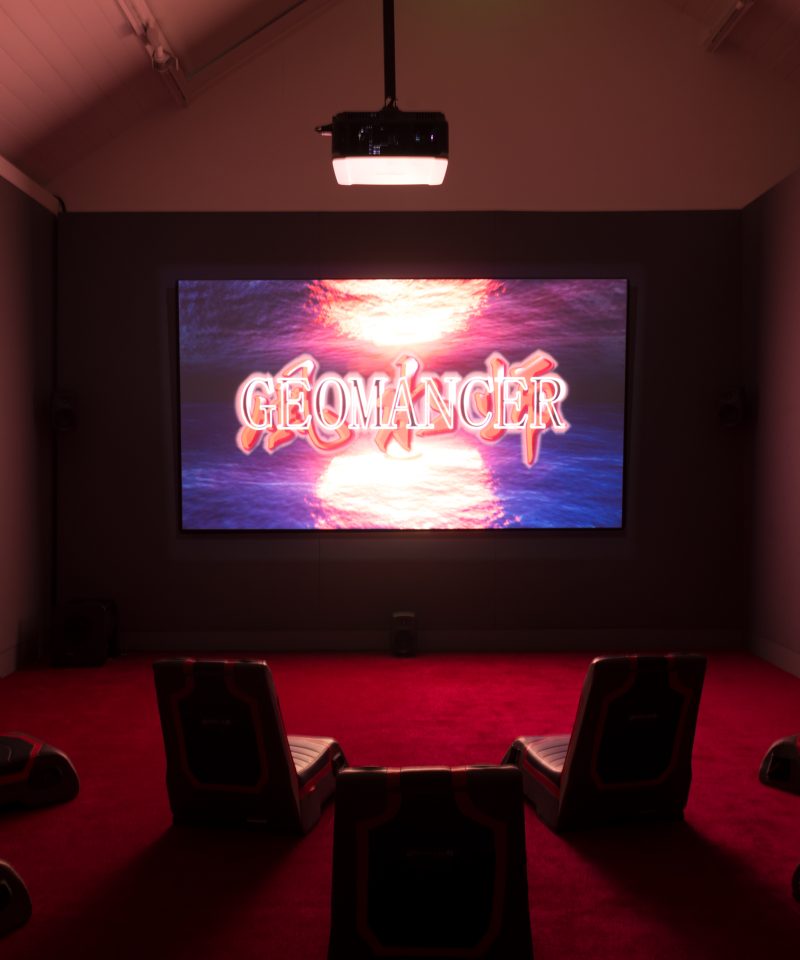This year’s Jerwood/FVU Awards exhibition is oriented around the titular theme ‘Neither One Thing or Another’. How do I represent what is neither one thing nor another? If it’s a point on a horizontal between two coordinates it ought to be dead centre (otherwise it’s more one thing than the other) and it follows that it’s equidistant from other coordinates, of which it is also neither, on vertical and diagonal axes, so I can plot a circle with it. Extend the same logic into three dimensions and you have a sphere; smooth, attractive, weightless in space – who imagined the geometry of indeterminacy could be so orderly, so satisfying? Of course it’s not.
Neither one thing nor the other suggests a contingent, split, multiple, dichotomy –a resistant, unrepresentable something. Based on a first impression the films featured – ‘And If In A Thousand Years’ (2017) by Patrick Hough and ‘Geomancer’ (2017) by Lawrence Lek – frustrate this expectation. Far from being ostentatiously contingent, they are image-rich, aesthetically robust and anchor their narratives in highly coherent subjectivities.
They have voiceovers (the gravity a voiceover exerts on any audio-visual output, no matter how random, should never be underestimated) that are consistent in tone, delivery and narrative continuity. This troubles the title and notional gist of the show, only if I assume that our narrators, in their apparently more or less intact self/thing-hood, are there to make matters relatable on the level of individual psychology. But in the subtending grounds and conditions of their identities, the gulf of discontinuity yawns – as, I suppose, it does for us all. ‘Listen Geo’ says a disembodied bot-voice that recites the Sutras in ‘Geomancer’, ‘all phenomena bear the mark of Emptiness.’ True enough, I tacitly concur – we can’t say we weren’t warned.
Both films are, in some broad sense, concerned with artificial intelligence or parallels thereof. It’s plainly more explicit in ‘Geomancer’. A CG animation set in a speculative future Singapore in 2065, the whole film is narrated by an AI, Geo, that aspires to be an artist – improbable, you might think, according to current received wisdom, but hardly impermissible. In 2065, however, art made by AI will be expressly and aggressively negated: ‘Faced with the crisis of human obsolescence, people built walls around the last refuge of humanity; art.’ A significant paradigm shift has occurred – a technological singularity – causing the primacy of human creativity to be seen, rightly or wrongly, as under threat.
When did this shift happen? In consensus reality, it was March of last year (‘Geomancer’ fictions the moment back by a couple of decades) when Lee Sedol, a world champion of the Chinese board game Go, was defeated in four out of five successive games by AlphaGo, a computer programme developed by the artificial intelligence company DeepMind Technologies. Lee owed his only victory to a decisive manoeuvre described by commentator Gu Li as a ‘Hand of God’ move, making it clear that the resourcefulness of human intellect must, by its very nature, be divinely sanctioned. Wherever it is manifest it is more mysterious and hence more beautiful than any algorithm.
This moment is re-imagined in the prologue to ‘Geomancer’ entitled ‘Swansong of the Genius’ as the 2045 E-Sports Olympics. DeepMind is fictionalized as FarSight, AlphaGo becomes OmegaGo.That may have been an entirely pragmatic route around potential copyright issues or, if not that, it might be in keeping with the Sinofuturist tactic of studious imitation, replication and subtle rebranding. Sinofuturism is posited as the quintessential art movement of artificial intelligence which ‘… started as an anti-art movement; one whose principles were based upon the unique qualities of machine learning itself.’
It is also the certifiable degenerate art of the near future, delegitimized in every cultural platform for its affront to the sanctity of human genius. Art thus not only becomes repurposed as a sort of new Turing test, but also as a safeguard against iconoclasm. According to these strictly enforced parameters, Sinofuturism is not real art – it’s a bogus near approximation. Lawrence has devoted a near hour length essay film to the movement entitled ‘Sinofuturism (1839 – 2046 AD)’, a companion piece of sorts, briefly reproduced in ‘Geomancer’ as a cultural artifact. It can be viewed here. It characterises Sinofuturism as intimately tied to characteristically Chinese modes of industry, production, value and leisure. A critique of racial stereotypes is more prominent in Sinofuturism than in ‘Geomancer’ bringing to light a fundamentally Eurocentric orientation to genius fetishism.
‘And If In A Thousand Years’ is also narrated by a fabrication, fashioned from inorganic material by humans to perform as spectacle of media. It’s a film prop – a sphinx from the set of Cecil B. DeMille’s ‘The Ten Commandments’ (1923), dug out of the dunes in Guadalupe, California in 2014, 91 years after – as Hollywood lore would have it – DeMille ordered it buried along with 20 others like it and, essentially, the entire set. Evidence from the excavation actually suggests that the ‘lost city of DeMille,’ as it came to be known, was merely abandoned and not interred.
The sphinx has its own cognition, memory and emotion. It has its own voice too; discernibly a woman’s, though it’s not otherwise conspicuously gendered, with an Irish accent – not ersatz Hollywood Irish but unforced, for want of a better word, native or local. The local is a heavily weighted matter in Patrick’s work, as is the ersatz, the notionally inauthentic simulacrum. When I say that the sphinx in the film is a prop from ‘The Ten Commandments’, it’s perhaps misleading. In fact, what we see for the most part is actually a replica of the prop – the ‘real thing’ as it were is gigantic, cumbersome and in fragile repair. In its nostalgic rage, the sphinx’s monologue has the grandiosity of a mythic Norma Desmond, the faded Hollywood star the talkies left behind, as played by Gloria Swanson in ‘Sunset Boulevard’. ‘I am big’ Swanson famously bristled upon being told she ‘used to be big.’ ‘It’s the pictures that got small.’
Being at a second remove from the ‘real thing’ – a replica of a replica – our sphinx may witness its own death (or at least dormancy) and resurrection. At one point it visits and reflects upon fragments of its own earthly remains in an exhibition at the Guadalupe-Nipomo Dunes Center. The sphinx got small alright and, if the Dunes Center rolls out a new line of key-fobs or paperweights for the gift shop, might get smaller still.
The emergence of the Sphinx is evocative of iconic desert emergences throughout the history of cinema. It’s like the excavation of demonic ‘Pazuzu in The Exorcist’ for example, or the discovery of the mysterious black monolith in ‘2001: A Space Odyssey’. Pazuzu and the monolith are certifiably mysterious things but the cinematic desert also conjures mysterious people, especially if they can signal the racial or cultural other, which makes me picture Omar Sharif drawing slowly in from the horizon in ‘Lawrence of Arabia’.
The final sequence of ‘And If In A Thousand Years’ sees the desert sands of cinema take on a stroboscopic hyperreality as a LiDAR scan. In this surveying process, highly valued in archaeology, every surface and object within range becomes a ‘point cloud’ – a desert of light points on a black background.
Geo has a similar emergence, at one point witnessing its own satellite body hoisted out of the water in flooded Singapore by a flock of drones, and it’s worth noting both environments are generally steeped in diffuse surfaces of unreliable solidity; more on that significance to follow shortly.
It would be drab to conclude without elaboration that Patrick’s sphinx is categorically ‘about’, or an illustration of the transcendent, animistic inner life of a film prop. It wouldn’t be untrue as such; it would just gloss over its intensity, its oscillation between artifice and authenticity, its tremulous flickering feedback between fact and fiction. It would also disregard the work’s attention to site – this is not Patrick’s first excursion to an abandoned film set. See ‘The Hills Have Eyes’, (2012) named after the feature film of the same name: Not Wes Craven’s 1977 ‘original’, a cult favourite among genre fans, and thus bestowed a certain fringe prestige. Patrick’s film refers instead to the 2006 re-make, little more a footnote in the mania for re-makes that gripped horror cinema in the mid 2000’s, dismissed as a mediocre cash-in by mainstream and genre critics alike.
Patrick’s film was shot at the constructed and abandoned gas station left by the makers of the 2006 film by the side of a road in Morocco, dilapidated but more or less intact. The site, like our sphinx, is a second generation knock-off and both are borne of the same trans-geographic sandy movie vista. The cinematic desert is a portal – whatever and whomever comes to occupy this space performs a hyper-mediated performance of self.
At a public screening at Jerwood Space of earlier work by both artists, including ‘The Hills Have Eyes’ among others, I was invited to give a brief introduction and share some thoughts on what, if any, affinities they might share. My contribution hinged on what I saw as a phenomenology of weight. There was an exchange within and across the work that speaks to an intimate experience of weight – or weightlessness – and the metaphors associated with it. Although that reading was particular to the films screened on that particular occasion, the convergence of the two works becomes more glaring to me every time I see them.
I experience weight, intuit it more than measure it, as a metric of reality. I sense the materiality of, first and foremost, the object that is my body, then garments, tools, food, mobile items of furniture or anything else I can move. By the relative ease or strain with which I can move it, I apprehend it in relation to the ground we share, which, unless it’s radically compromised, I will always assume to be stable. If it’s not stable it undermines my relationship to other things.
On the relative weightlessness of the gaming subject: it strikes me that computer games never seemed to convey the experience of bodily weight. This low gravity subjectivity is a given in Lawrence’s digital animations. As a player I jump from one plane to another like a feather with muscles. I glide without friction over, around, sometimes – through homogenous surfaces – or maybe they move around and through me. In some cases my perspective actually trails above and behind my body like a kite. When it’s like this, with my disembodied eyes floating diagonally from the back of my skull, I too can witness my own death and resurrection in the round. And when I turn my head left or right to take in my surroundings my own field of vision doesn’t merely shift, I see the world wheel around me.
This game space, the space of the first person player is a systemic, Euclidean terraform that puts me at its endlessly mobile centre, so why do I feel dangerously untethered? Why do I distrust the ground? Maybe, without my intuition for weight, I sense that its stability is illusory – maybe it’s in free fall at exactly the same rate as my body. In her essay ‘In Free Fall: A thought Experiment on Vertical Perspective’, Hito Steyerl has observed that ‘Falling is relational… whole societies around you may be falling just as you are. And it may actually feel like perfect stasis.’
The term neither one thing nor another, in light of this reading takes on an alarming tenor – one of foundational crisis, of schism. Volleyed at length against one another, the films begin to represent a peculiar but not uncommon condition of life in such rapid flux between virtual and physical space that the distinction grows faint. Each artist makes an approach to this space-out-of-joint from a dramatically different position. Both benefit from our casual fluency in the languages of mass media, granted. But the slippage between the empirically real (location) and fictional (scene) spaces in Patrick’s work contrasts significantly with the allegorically real woven into the fabric of Lawrence’s self-evidently constructed virtuality. They arrive, nonetheless, at a common dislocation, a common hauntedness. I experience a classical haunting – in physical space that, due to some dimensional rupture, hosts radically ‘Other’ sentient presences – confident at least that I am the living human subject. My weight, the strain in the floorboards under my feet, the resistance of solid walls, reassures me when nothing else will. But weightless in the haunted flux of no common ground, I could be the ghost.



